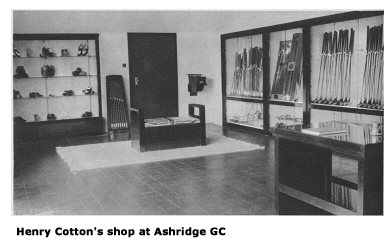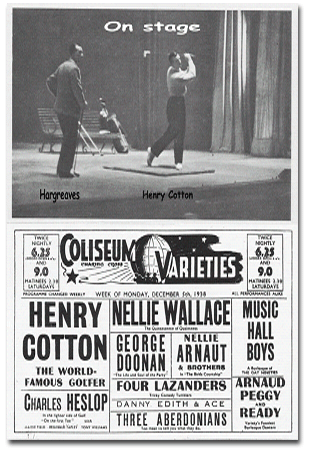|
| |
 many short trips across the channel to play in tournaments. By the
beginning of 1937 he was ready to come back and Lord Rosebery,
President of the five-year-old Ashridge club in Hertfordshire,
persuaded him to become the club’s pro and, in Henry’s words, help
them ‘get ahead’. His conditions of acceptance included being made
an honorary member, almost unheard of then, and a new shop with
showcases and fittings equal to anything in Bond Street, including
Zebra-hide-covered seats and armchairs brought over from Waterloo.
He even employed a full-time secretary to deal with his office work.
He had a handsome house built in Ashridge Park, the former estate of
the Duke of Bridgewater (the Canal Duke), which he named
‘Shangri-la’, after the valley in James Hilton’s book: The Lost
Horizon. many short trips across the channel to play in tournaments. By the
beginning of 1937 he was ready to come back and Lord Rosebery,
President of the five-year-old Ashridge club in Hertfordshire,
persuaded him to become the club’s pro and, in Henry’s words, help
them ‘get ahead’. His conditions of acceptance included being made
an honorary member, almost unheard of then, and a new shop with
showcases and fittings equal to anything in Bond Street, including
Zebra-hide-covered seats and armchairs brought over from Waterloo.
He even employed a full-time secretary to deal with his office work.
He had a handsome house built in Ashridge Park, the former estate of
the Duke of Bridgewater (the Canal Duke), which he named
‘Shangri-la’, after the valley in James Hilton’s book: The Lost
Horizon. Henry’s retainer was only £100 a year, which was about the same as mine at West Cheshire, but he was not ‘tied down’ at the club and he could charge at least £1 and up to £5 for a lesson against the ‘going rate’ of around 5s (25p) an hour. The club built a practise ground for him, with covered sheds for winter training. A round with Henry at Ashridge cost £10 and Clubs that invited him to play exhibition matches would pay him £300 for a single and £200 for a four-ball.  In 1938 he accepted an invitation to demonstrate his expertise in a
fifteen minute stage act, which toured the country to packed houses
and topped the bill at the Christmas Variety show at London’s
Coliseum. Assisted by his caddie, Hargreaves, he took the audience
through a beginner’s lesson and hit a variety of shots, finishing
with a remarkable display of accuracy. People were asked to stand up
in various parts of the auditorium and Henry landed balls into their
hands. Hargreaves recalled in Caddie in the Golden Age that Henry
was concerned during the second week when he heard that General
Critchley had taken the first two rows of the stalls. The ‘General’
had a reputation as a hell-raiser and “…. As Henry had given him
several thrashings at golf and fairly short shrift in conversation,
the rumour around the theatre was that a collective ‘raspberry’ was
in preparation”. He need not have worried, the anticipated heckling
was lost in the cheers and the act went down even better that night.
The white-headed driver he used in the act can be seen in the Golf
Museum at St Andrews. Heading the supporting acts was Nellie
Wallace: ‘The Quintessence of Quaintness’, whose song “My old Man
said follow the van…” would be Henry’s cue to be ready in the wings.
For the 16 week run Cotton received £10,000. In 1938 he accepted an invitation to demonstrate his expertise in a
fifteen minute stage act, which toured the country to packed houses
and topped the bill at the Christmas Variety show at London’s
Coliseum. Assisted by his caddie, Hargreaves, he took the audience
through a beginner’s lesson and hit a variety of shots, finishing
with a remarkable display of accuracy. People were asked to stand up
in various parts of the auditorium and Henry landed balls into their
hands. Hargreaves recalled in Caddie in the Golden Age that Henry
was concerned during the second week when he heard that General
Critchley had taken the first two rows of the stalls. The ‘General’
had a reputation as a hell-raiser and “…. As Henry had given him
several thrashings at golf and fairly short shrift in conversation,
the rumour around the theatre was that a collective ‘raspberry’ was
in preparation”. He need not have worried, the anticipated heckling
was lost in the cheers and the act went down even better that night.
The white-headed driver he used in the act can be seen in the Golf
Museum at St Andrews. Heading the supporting acts was Nellie
Wallace: ‘The Quintessence of Quaintness’, whose song “My old Man
said follow the van…” would be Henry’s cue to be ready in the wings.
For the 16 week run Cotton received £10,000.Henry was to be called upon to perform the act again in 1953, by Royal command, when he was invited to take part in Queen Elizabeth’s Command Performance. The act was as good as ever and ended triumphantly with a ball landing in the hands of a volunteer in the Royal Box – the Duke of Edinburgh, an honorary member of the R&A, but a non-golfer. His son Andrew was to be the only member of the family to follow in the footsteps of his great uncle and grandfather - Henry’s Royal pre-war partner, Edward V111 and his brother ‘Bertie’ - George V1 and become Captain of the R&A. Incidentally, neither of the British Royal golfers ever played in competition as King. That distinction fell to King Leopold of the Belgians in 1939, when he became the first (and only) reigning Monarch to play in a national championship. In August of that year, with war looming, he participated in the Belgian Amateur. He went out in the second round, NEXT |
